
(Most recent first. Click on the titles for fuller descriptions).
28th November 2017
For this, the final meeting of 2017, the talk was given by club member Alberto Hinrichsen, who had been born and lived in Chile until forced to leave for his own safety after the military coup staged by General Pinochet in 1973. In an earlier talk on this subject, Alberto had described the political and social changes that occurred in Chile since the 1920s but on this occasion he concentrated more on the effects of these changes on him personally.
Although he grew up in one of Chile’s privileged landowning families he became aware of the inequalities between the rich and poor of that country at a young age and he related how a number of critical events in his life, and on the international scene in the 1960s, had led him down the path of socialism. Hence, he was a supporter of President Allende who, in 1970, was elected with a programme to build Socialism by democratic means. Allende’s reforms were fiercely resisted by the opposition parties (backed by the USA) and in 1973 he was ousted by a military coup led by General Pinochet who then set about persecuting socialists and political critics. In this period of Chile’s history it is estimated that 30,000 were killed, 2,000 people ‘disappeared’ and hundreds of thousands were imprisoned. Of the country’s population of 12 million, ½ million fled into exile and Alberto was one of these. He first escaped to Argentina but then, in 1976, a right-wing military coup similar to the one in Chile three years earlier placed him in peril in that country, too.
As in the case of his first talk, at a dramatic point in his narrative Alberto ran out of time, leaving his audience eager to hear its conclusion at a future meeting.
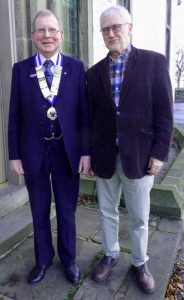
Ray Smith and Alberto Hinrichsen
14th November 2017
The talks given to our club are usually by members of the club itself but at this meeting the speaker was a guest, Peter Clare, of the family firm E A Clare and Son, the oldest business on Merseyside making tables and accessories for snooker, pool and billiards. As Peter explained, billiards has a long history from its inception in the 15th Century. Originally, it was played on a wooden table without pockets but with hoops similar to those used in croquet. The balls were shoved with wooden sticks called ‘maces’, rather than struck with a cue as nowadays. In 1826, John Thurston introduced tables with a slate bed (in place of wood) and later added rubber cushions to the edge boards.
Throughout the 19th Century many of the tables were ornately decorated and, as the speaker’s photographs showed, there are several examples of these in the museum attached to E A Clare’s premises. Some tables were made of unusual shape, such as octagonal and oval, and experiments were tried using cast iron or even concrete, but a table with a slate bed and wooden frame remains the norm.

Peter Clare and Ray Smith
24th October 2017
This meeting was our AGM. The chairmanship was handed over from Ainslie Kelly to Ray Smith who then introduced the speaker, club member John Perry.
The subject of John’s talk was the evacuation, during World War II, of vulnerable people from inner cities to rural communities. As early as 1938, foreseeing the threat of war against Nazi Germany in which the civilian population would be under threat from enemy bombing, the British government started making plans for this mass movement of civilians. So it was that when war did break out in September 1939, the country was reasonably well prepared for this operation.
In the following months, an estimated 3½ million people – mostly children – were involved. Shepherded by their teachers to the local railway station, this part of the process was usually orderly, and the railways handled this extra traffic very effectively. However, at the various destinations, attempts to keep siblings and friends together when being billeted to their temporary homes were not always successful. Another difficulty could be the social mis-matching that could occur between the evacuees and their hosts. Many of the former, coming from deprived and poor inner-city homes, found themselves living with more affluent rural families with the result that tensions and misunderstandings arose between them.
This, however, was not the speaker’s personal experience. He had been evacuated from his home in Birmingham and spent time living in various small towns in the Midlands where he had attended the local schools. All these years later, he believes that he suffered no hardship from his experiences.
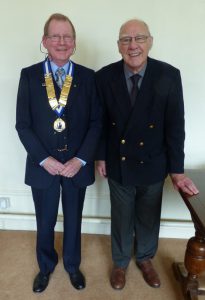
Ray Smith and John Perry
10th October 2017
To many people, the ability to lead others is a quality with which they are born but, hopefully to the majority, leadership is a skill that can be learnt. At this meeting our speaker was club member Peter Holt who described how he had made a career of studying and teaching these skills.
After college, he joined the armed forces, firstly in the Royal Navy Instructor Branch then the Royal Army Educational Corps. Officer training in the Services is very much focussed on leadership and it was during his time at the naval colleges (Dartmouth and HMS Ganges) and at the Royal Military Academy Sandhurst that Peter received his deep insight into the subject. As he explained to his audience, put simply, leadership is about people and about influencing those people so that they act together in order to achieve a shared goal.
Following his time in the Army, Peter moved to the National Police Staff College at Bramshill where he built on his previous experience. His role was to help develop senior police officers with the leadership and management skills necessary to perform their challenging job. Later career moves saw him set up his own leadership consultancy and also become a tutor on the Executive Leadership Programme at Henley Business School.
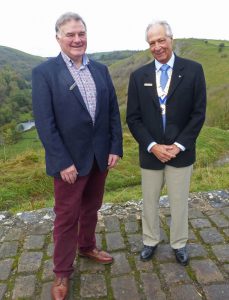
Peter Holt and Ainslie Kelly
26th September 2017
Following on from talks in the past few months on eminent subjects such as Chatsworth, and Admiral Collingwood, we were brought down to earth at this meeting when the speaker, club member Tony Byrne, took as his theme the history of the WC.
The disposal of human waste did not become a problem to society until people started to live together in groups and there is evidence, some dating back to 4000BC, of the methods used for dealing with it. Giving examples from as far apart as Orkney, Crete and India, Tony explained how primitive but effective drainage systems had been used to flush out the communal latrines. The most sophisticated of such arrangements were developed by the Romans. However, once they had abandoned Britain (c.AD400), their civilising influence was lost and the native population reverted to its former practice of disposing of its waste wherever convenient, often directly into the streets which thereby became open sewers. With a rapidly increasing population this situation became intolerable and, in the nineteenth century, sewage systems were being built in the major cities. At the same time, water closets in the basic form that would be recognizable today were beginning to be mass-produced in the pottery factories of Wedgwood, Twyford, Doulton and others.
These days, in the developed world we tend to take the disposal of our human waste very much for granted but, as Tony reminded us, there are still huge numbers of people across the globe who do not have the benefit of efficient sewage systems and suffer from many diseases in consequence.
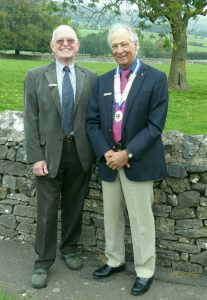
Tony Byrne and Ainslie Kelly
12th September 2017
The intriguing title of this talk was ‘I am still thinking’. When asked prior to the meeting to provide a little more information the speaker, club member Jonathan Wicksteed, gave the enigmatic response that his talk about thinking would guarantee to get his audience thinking. And so it proved, because his subject was actually about artificial intelligence; how it had developed so far and its potential effects in the future. In fact, the term is little understood by the general public who tend to associate it with science fiction and therefore fail to realise that it is already impacting on our lives.
In its simplest form, artificial intelligence lies behind the working of the robotic machines which are now commonly found in factories and retail distribution centres. But more recent developments in the science behind robot technology have been exponentially rapid such that the future, whilst potentially exciting, is also unpredictable or even menacing. Taking the example of driverless cars, we already have the capability of making and operating these vehicles but have not yet resolved many of the fundamental questions concerning their use. For instance, in the event of a collision or other failure in the system, who is responsible for the consequences? Is it the vehicle’s manufacturer, or its designer, or its operator, or any combination of these?
Our speaker described numerous ways in which artificial intelligence can be used beneficially – in medical advances, bio-engineering, nanotechnology and the like – but he expressed concerns about the real possibility of machines being created that could run out of control. Altogether, this was a talk that certainly got his audience thinking.
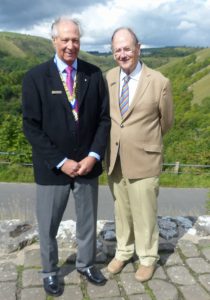
Ainslie Kelly and Jonathan Wicksteed
22nd August 2017
Horatio Nelson is widely recognized as the hero of the Battle of Trafalgar but less well-known is the part played by his second-in-command, Vice-Admiral Cuthbert Collingwood. At a today’s meeting, club member Peter Stubbs gave an extremely knowledgeable talk about the life and career of this great friend of Nelson.
Born in Newcastle-upon-Tyne in 1748, Collingwood joined the Navy at the age of twelve as a volunteer on board his cousin’s ship, HMS Shannon. Five years later he became a midshipman and, after a further seven years was commissioned as a lieutenant. It was at this time that he first met Nelson and, in spite of the ten-year age difference between them, they became close friends. This was in spite of the fact that they were men of very different character – unlike Nelson, Collingwood was quiet and reserved but they were both brilliant tacticians and excellent man-managers. In this latter regard, Collingwood’s style of leadership when commanding his ships was based on fairness and firmness, and he was greatly respected by those who served under him.
He saw action in a number of sea battles against the French, culminating in Trafalgar where it was his ship, HMS Royal Sovereign, which led one of the two attacking lines of ships into the French fleet, Nelson leading the other line in HMS Victory. On Nelson’s death later in the battle it was Collingwood who took command of the British fleet. Afterwards, he was raised to the peerage and, as Baron Collingwood, died in 1810. Appropriately, in view of their long and close friendship, Nelson and Collingwood are buried alongside each other in St Paul’s Cathedral.

Peter Stubbs and Ainslie Kelly
8th August 2017
At this meeting we were delighted to welcome William, Lord Burlington, who was introduced by club member Andrew Lloyd. Lord Burlington gave an enthusiastic and unforgettable presentation, concentrating on the future for Chatsworth, based on the core values of always improving, decency and being inclusive. Equally important is its natural heritage and the preservation of one of the Peak District’s most valuable assets.
We were told that as part of the 10-year sustainability plan from 2010, many great strides have already been made in areas such as reduction of waste, renewable energy in the form of LED lighting, biomass heating units using local timber, solar power, as well as future plans for hydro. As an example, a few years ago, tons of waste were being sent to landfill, but that figure is now reduced to nil; recycling and incineration (waste to energy) has taken over. Plans for the future are all centred around people, both staff and visitors. For example, more investment is being made in staff training; renewed efforts are being made to ensure accessibility to an ever-broader spectrum of visitors to the house, gardens and farmyard, as part of the education process for all ages.
The achievements of the work towards sustainable business practices have been recognized by several awards including the Peak District Environmental Quality Mark. There is a lot going on behind the facades that we all enjoy!
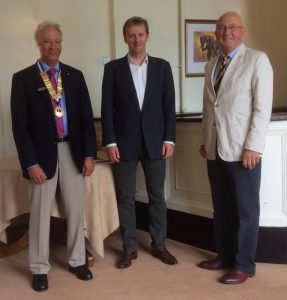
Ainslie Kelly, William Burlington and Andrew Lloyd
25th July 2017
Today’s speaker was club member John Winkworth-Smith, whose talk reflected his involvement in farming and his interest in the history of cattle droving. He described how, for many years, animals bred in the upland areas of Britain (mainly Scotland and Wales) were taken by foot to the markets of the south east of England. This activity had been taking place to a limited extent for centuries but it was with the human population explosion of the seventeenth and subsequent centuries that it became a major trade and, in doing so, contributed significantly to the economy of Scotland in particular.
Livestock – mainly cattle and sheep – would be gathered from individual farms to form herds or flocks of up to 200 beasts and then driven to markets which, in the case of ‘drives’ from Western Scotland to London, could be up to 600 miles. The pace was necessarily slow because the animals had to be fed, watered and rested en route, and the longer journeys could take six weeks. In charge of these mass movements were the drovers. They were a tough and hardy breed of men who, as temporary custodians of the farmers’ livestock until it was sold, needed to be honest and reliable. They also had to be knowledgeable about the country through which they passed, and to be good businessmen.
Life was made difficult for the drovers by the introduction of toll gates (which cost both money and time) and by the Enclosures Acts which deprived them of open fields and ‘common’ land for grazing. Eventually, it was the development of the railways which dealt the death blow to the ancient practice of droving.
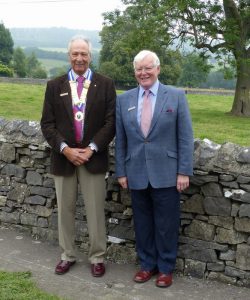
Ainslie Kelly and John Winkworth-Smith
11th July 2017
All car drivers will be aware of the potential dangers of driving through a red traffic light. Any resulting collision can cause serious injury or even death. In similar circumstances on a railway, where the weight and speed of trains can be very much greater than those of road vehicles, a collision caused by a train driver passing a signal at danger (‘SPAD’) could be catastrophic.
At today’s meeting, member Brian Holland spoke on this subject and it was clear that he had studied it in meticulous detail. As he discussed, from the earliest days of the railways in the nineteenth century, there have been many instances when, for whatever reason, a train driver has failed to stop at a danger signal. The cause may be mechanical (e.g. brake-failure) but human errors (caused by inexperience, carelessness, fatigue, or other similar factor) have frequently played their part.
In his talk, Brian described how a number of safety systems to prevent SPADs had evolved on the railways of Britain since the start of the twentieth century and he gave examples of rail crashes that would have been avoided if the methods of train protection now in operation had been in place at the time. He also considered future developments by which, through the use of digital technology, the need for on-board train drivers could be eliminated. However, whether the travelling public would willingly accept such systems is another matter.
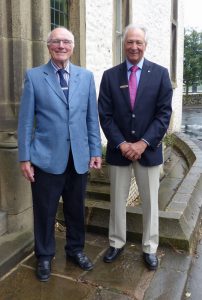
Brian Holland and Ainslie Kelly
27th June 2017
Over the centuries the Scottish Border country has been home to many famous families and it was the history of one such family that was the subject of today’s talk by club member, Pat Erskine-Murray. His distant ancestor was one Gideon Murray, who lived in the latter part of the sixteenth century. For reasons that are now unclear, Gideon had been wrongfully imprisoned but was later released on the direct order of the then king of Scotland, James VI (who was to become James I of England). Finding favour with the King, Gideon was knighted and in 1594 was granted lands on the banks of the River Tweed at Elibank near Selkirk.
From these beginnings, the Murray family came to prominence both locally and internationally. One of the most notable was lieutenant-colonel James Murray who served under General Wolfe at the Battle of the Plains of Abraham (1759) outside Quebec City in Canada. The British forces won this conflict, and the city fell into their hands. James Murray was appointed governor, firstly of the city itself and later the entire province of Quebec where he was renowned for his even-handed treatment of the defeated French-Canadians.
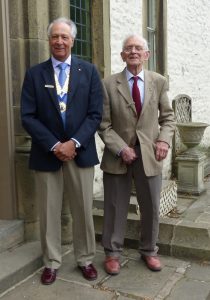
Ainslie Kelly and Pat Erskine-Murray
13th June 2017
Rather like buses that come along in threes, talks to the club about Chatsworth and its people seem to be following the same pattern this year. In May, the subject was the late Duchess of Devonshire and in August, Lord Burlington (son of the present duke) is to talk about future plans for the estate. Neatly fitting the gap between these two talks, today’s speaker was a guest, John Oliver who, actually having been born there, had spent sixty years living and working at Chatsworth. John’s father was a chauffeur and his mother worked in the kitchens, and John grew up treating his magnificent surroundings as his natural playground. It was during his childhood, when he had the job of looking after the chickens that he first made the acquaintance of the Duchess (Deborah). Then, at the age of sixteen, he was taken on as an apprentice joiner from which he progressed eventually to the position of Comptroller at Chatsworth at the time of his retirement.
With all his knowledge and experience gained over so long a period, it was inevitable that John was able to relate numerous hilarious anecdotes and to impart a collection of fascinating facts about the House and its Estate. His audience was greatly entertained and, at the end of the talk, keen to ask questions and make comments. John had been introduced by club member, Alan Elsmore who also delivered the vote of thanks.
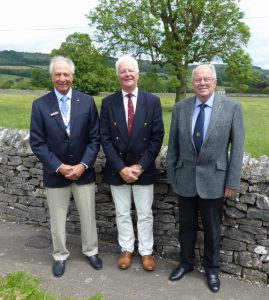
Ainslie Kelly, John Oliver and Alan Elsmore
23rd May 2017
‘A land of blue skies and distant horizons’ is how today’s speaker, club member Neil Spaven, described Mongolia. In the company of his son and a group of other walkers, he had taken part in a week-long sponsored trek in that country in support of the charity, Teenage Cancer Trust. Illustrating the accuracy of his description, many of Neil’s photos showed a sparsely-populated country of rolling grassland under cloudless skies.
Three times the size of France but with a population of only three million, Mongolia is one of the least densely populated countries in the world and possibly one of the least travelled. Sandwiched between Russia and China, it is mountainous in the north and west. These mountains then give way to grassy steppe (where Neil’s party trekked). Finally, in the south of the country is the Gobi desert. Much of the rural population is nomadic, living in large portable round tents (‘gers’) traditionally made of animal skins but, as Neil’s photos showed, now often with more modern materials (plastic and metal sheets) included in their construction.
At the end of their trek, Neil and his son chose to travel from Mongolia’s capital, Ulaanbaatar, to Beijing by train rather than flying. This was a 30-hour journey on the Trans-Mongolian Railway which is a branch of the most famous Trans-Siberian.

Neil Spaven and Ainslie Kelly
9th May 2017
The life story of the late Duchess of Devonshire (born Deborah Mitford) has been told many times but at today’s meeting a new perspective on the history and achievements of this remarkable woman was given by the speaker, Simon Seligman. From childhood Simon had wanted to work at Chatsworth and it was after he had graduated with an Arts degree that he took the bold step of writing to the Duchess and asked for a job. His letter must have caught the Duchess’ attention because it eventually led to his being given the opportunity to join the staff at Chatsworth. This was in 1991 and, for the next 19 years his career progressed to the point at which he had become Head of Communications there. Over this time, he developed a close working relationship with the Duchess and, as was clear from the way in which he talked about her, he came to admire and respect her immensely.
As is widely known, Deborah Mitford was the youngest of six sisters, most of whose controversial lives were notable for their political sympathies, ranging from communism to fascism. Deborah, however, was more conventional. At her marriage in 1941 to Andrew Cavendish, second son of the 10th Duke of Devonshire, she would have expected her future life to be one of straightforward, if upper-class, domesticity with, at the time, no idea of the high profile public life that was to follow as a result of the premature death in World War II of the heir to the dukedom, William Cavendish.
When the 10th Duke died in 1950, the Inland Revenue claimed £4.8 million in death duties from the Cavendish estate and it fell to the new Duke and Duchess (Andrew and Deborah) to settle this enormous claim. By disposing of many of the Cavendish lands, property and works of art, they finally cleared the debt but it took 17 years to do so. Throughout her life as the Duchess, working in close partnership with her husband, she was the instigator of, and driving force behind, the hugely successful business that Chatsworth has now become.
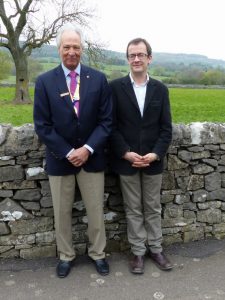
Ainslie Kelly and Simon Seligman
25th April 2017
It is now widely accepted that excessive exposure of the human skin to strong sunlight can lead to a form of cancer known as melanoma. Less commonly known is the fact that melanoma can form within the eye; and it was these ophthalmic tumours – their diagnosis, treatment and prognosis – that were the subject of today’s talk.
Introduced by club member and retired General Practitioner Ken Fleming, the speaker was Professor Ian Rennie of Sheffield Medical School who described the important advances made in this particular field of medicine over the past thirty years, many of which were developed by his team in the Sheffield Ocular Oncology Service. The success of this department led to its being included in the NHS National Commissioning Group of highly specialised services in 1997, which increased its funding significantly. It is now widely recognized for the excellence of its work, both nationally and internationally.
At the time that this specialised unit was established in 1985 there was little effective treatment available for dealing with ophthalmic tumours, with the result that, in most cases, the diseased eye would have to be removed. There was also a high incidence of misdiagnosis, which meant that a patient’s eye would have been removed unnecessarily. However, thanks to the work carried out by Professor Rennie’s team in developing several techniques involving different forms of radiotherapy and surgery, there is now a much better chance that the patient’s eye can be saved and, in most cases, restored to full vision.
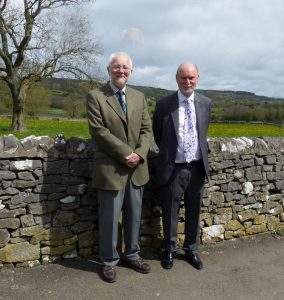
Ken Fleming and Professor Ian Rennie
11th April 2017
Today’s speaker, club member David Grattidge owned up to a fear that his audience, on learning that his talk was to be about philosophy, might find it to be a dull and uninteresting topic. He need not have worried because he proved to be extremely knowledgeable and skilled at communicating his enthusiasm for the subject to others. As an introduction he said that his talk was aimed at explaining why he has spent a great deal of time since retirement reading, writing and generally thinking about philosophy. He gave details of his personal history as a way of showing how philosophy became important to him. He tried to answer questions like: ‘What is philosophy’? and ‘What is the point of philosophy’?
David also gave an outline of his project to try and appreciate the whole history of Western philosophy – a task he described as unachievable but worthwhile. In distinguishing philosophy from other related areas of study he quoted Bertrand Russell: “Science helps us to have some degree of certainty about the world, and theology gives us reasons for feeling certainties about faith or religious beliefs, but philosophy deals with those things we cannot know, and it helps us to live with that uncertainty”. Unsurprisingly, in view of the nature of the subject, there was much discussion among his listeners at the end of David’s talk.
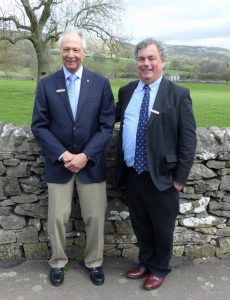
Ainslie Kelly and David Grattidge
28th March 2017
The talks given to our Club are invariably of a very high standard but even the best of these were eclipsed by today’s guest speaker, Simon Harris. The full (and intriguing) title of his talk was ‘Horatio Nelson – his Wounds, the Seventh Commandment and the Festival of Priapus’.
A retired consultant anaesthetist, Simon could appreciate the serious and traumatic nature of the many wounds suffered by Nelson during his career in the Navy and, despite the gruesome nature of these wounds, Simon described, in a very knowledgeable and unexpectedly entertaining manner, how they had been sustained and treated. Having lost the use of an eye at the siege of Calvi in 1794, Nelson subsequently suffered severe wounds to his abdomen during the battle of St Vincent in 1797 and, later that year during fighting off Santa Cruz in Tenerife, received injuries requiring the amputation of his right arm. Early in the following year, at the battle of The Nile, he received a serious head wound. Finally, as we all know, this heroic man was killed at the battle of Trafalgar in 1805.
As well as discussing Nelson’s wounds, Simon also took a somewhat irreverent look at this famous man’s legendary love life – hence the references in the title of his talk to the Seventh Commandment and the Ancient Romans’ notorious erotic art dedicated to the god, Priapus.
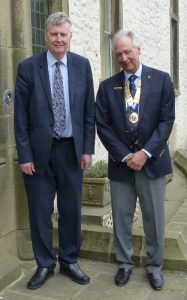
Simon Harris and Ainslie Kelly
14th March 2017
Now a regular event on the Club’s calendar, the annual debate this year took as its topic the proposition that ‘The British railway system should be re-nationalised’. The two club members leading the debate were David Webb who made the case for re-nationalisation and Robbie Jones who opposed it. Following the opening submissions, both of which had clearly been carefully researched and which were delivered in articulate and persuasive terms, the debate was enthusiastically continued with numerous contributions from the floor.
The overall mood of the discussion was that, although there are many problems associated with the privatised railway network, re-nationalisation would not be the answer to solving them. The point was made that irrespective of the criticisms that can be levelled against the current arrangements, such as the complexity of the fares structure and the lack of a properly integrated transport system, the fact remains that passenger numbers have doubled since privatisation and, thanks to private investment, new trains are continually being introduced.
Several contributors to the debate expressed their view that the efficiency of nationalised industries frequently suffered from interference by politicians and incompetent direction by civil servants in matters beyond their experience. The debate concluded with a vote, which returned an overwhelming majority against the proposition.

David Webb, Robbie Jones and Ainslie Kelly
28th February 2017
The spectacular coastline of Norway was the subject of an illustrated talk by Gillian Dengel, wife of club member Theo. Showing a selection from the hundreds of photographs taken on the journey, Gill described a return voyage which they had made between Bergen and Kirkenes (on the Norway/Russia border) via the North Cape.
They had travelled on board one of the Hurtigruten fleet of Norwegian ferries and cargo ships which operate on this route. Hurtigruten (meaning ‘Fast Route’) was founded in 1893 and now has a fleet of a dozen vessels. Originally providing the only direct means of communication between many of the isolated settlements along the Norwegian coast, and the fastest between the major towns, the ships were an important life-line. However, more recently, as the road network on the mainland has been improved, the Hurtigruten role has changed to some extent and the later ships have been built to accommodate the cruise market as well as the existing ferry service.
The voyage made by Gill and Theo covered 2,500 nautical miles and the ship called at thirty four ports, of which twenty two were within the Arctic Circle. It being September, they were too late in the year to witness the midnight sun and too early for the Aurora Borealis but, as proved by their photos, they saw many interesting and attractive sights en route.

Theo and Gill Dengel
14th February 2017
Club member Don Naybour looked at how the big companies failed to capitalise on the use of new technologies in the growth of the Personal Computer, leaving newcomers like Bill Gates (Microsoft) and Steve Jobs (Apple) to come from almost nothing to lead two of the largest companies in the world. This was a story of people and their decisions taken in a fast-changing world.
24th January 2017
Our guest speaker was local hotelier Eric Marsh whose main subject was aircraft aerobatics. However, before embarking on this topic, he described how his career in the hotel business had developed. After leaving school he attended a catering college and then trained in hotel management in some of the finest hotels, including the Dorchester in London and the George V in Paris. In 1975 he acquired the lease of the Cavendish Hotel in Baslow. On the expiry of this lease in 2008 and the emergence of Peak Hotel Management, Eric was awarded the contract to manage the Cavendish as Chatsworth’s key Derbyshire property. He now owns and runs the George Hotel at Hathersage and continues a long-standing association with aviation.
He is a member and Contest Director of the British Aerobatics Association. As he explained, the main purpose of aerobatics is the flight testing of new aeroplanes. From this follows the sport of aerobatic displays and contests. To illustrate how competitions are judged, Eric showed video clips of aerobatics displays and gave a commentary on the manoeuvres being carried out and the method of marking each competitor’s performance.

Eric Marsh and Ainslie Kelly
10th January 2017
We started the New Year in fine style with an informative and entertaining talk by club member, John Broughton, whose topic was The Coastguard Service. John started his talk by pointing out that a 999-call can be dialled to summon the assistance of not only the Fire, Police and Ambulance emergency services but also the Coastguard or Mountain Rescue. Here in Derbyshire, a county further from the sea than any other in Britain, we are generally unfamiliar with the work carried out by coastguards but in many respects it is similar to that of our local Mountain Rescue teams. In both cases, teams of (mostly) volunteers give their time and energy to helping people in difficulties or injured, usually outdoors.
The speaker, who had been a member of a coastguard team in West Wales for fifteen years, described the specialist role – cliff rescue – carried out by his team. He related several anecdotes to illustrate how they had saved lives in a variety of complicated and often humorous ways. He also explained the overall structure and workings of the Coastguard Service with its responsibilities for the safety of shipping, one of which is the coordination of search and rescue missions at sea. This was a fascinating talk which prompted a lively question and answer session at the end.

Ainslie Kelly and John Broughton

© Bakewell and District Probus Club, 2014-2024